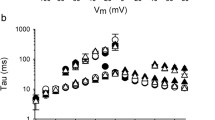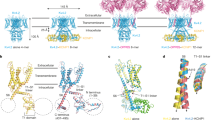Abstract
Kir3 channels control excitability in the nervous system and the heart. Their surface expression is strictly regulated, but mechanisms responsible for channel removal from the membrane remain incompletely understood. Using transfected cells, we show that Kir3.1/3.2 channels and delta opioid receptors (DORs) associate in a complex which persists during receptor activation, behaving as a scaffold that allows beta-arrestin (βarr) to interact with both signaling partners. This organization favored co-internalization of DORs and Kir3 channels in a βarr-dependent manner via a clathrin/dynamin-mediated endocytic path. Taken together, these findings identify a new way of modulating Kir3 channel availability at the membrane and assign a putatively novel role for βarrs in regulating canonical effectors for G protein-coupled receptors.







Similar content being viewed by others
References
Ma D, Zerangue N, Raab-Graham K, Fried SR, Jan YN, Jan LY (2002) Diverse trafficking patterns due to multiple traffic motifs in G protein-activated inwardly rectifying potassium channels from brain and heart. Neuron 33(5):715–729
Lunn ML, Nassirpour R, Arrabit C, Tan J, McLeod I, Arias CM, Sawchenko PE, Yates JR 3rd, Slesinger PA (2007) A unique sorting nexin regulates trafficking of potassium channels via a PDZ domain interaction. Nat Neurosci 10(10):1249–1259. doi:10.1038/nn1953
Munoz MB, Slesinger PA (2014) Sorting nexin 27 regulation of G protein-gated inwardly rectifying K(+) channels attenuates in vivo cocaine response. Neuron 82(3):659–669. doi:10.1016/j.neuron.2014.03.011
Hibino H, Inanobe A, Tanemoto M, Fujita A, Doi K, Kubo T, Hata Y, Takai Y, Kurachi Y (2000) Anchoring proteins confer G protein sensitivity to an inward-rectifier K(+) channel through the GK domain. EMBO J 19(1):78–83. doi:10.1093/emboj/19.1.78
Hearing M, Kotecki L, Fernandez Marron, de Velasco E, Fajardo-Serrano A, Chung HJ, Lujan R, Wickman K (2013) Repeated cocaine weakens GABA(B)-Girk signaling in layer 5/6 pyramidal neurons in the prelimbic cortex. Neuron 80(1):159–170. doi:10.1016/j.neuron.2013.07.019
Padgett CL, Lalive AL, Tan KR, Terunuma M, Munoz MB, Pangalos MN, Martinez-Hernandez J, Watanabe M, Moss SJ, Lujan R, Luscher C, Slesinger PA (2012) Methamphetamine-evoked depression of GABA(B) receptor signaling in GABA neurons of the VTA. Neuron 73(5):978–989. doi:10.1016/j.neuron.2011.12.031
Ippolito DL, Temkin PA, Rogalski SL, Chavkin C (2002) N-terminal tyrosine residues within the potassium channel Kir3 modulate GTPase activity of Galphai. J Biol Chem 277(36):32692–32696. doi:10.1074/jbc.M204407200
Mora SI, Escobar LI (2005) Phosphorylation of a tyrosine at the N terminus regulates the surface expression of GIRK5 homomultimers. FEBS Lett 579(14):3019–3023. doi:10.1016/j.febslet.2005.04.056
Terunuma M, Pangalos MN, Moss SJ (2010) Functional modulation of GABAB receptors by protein kinases and receptor trafficking. Adv Pharmacol 58:113–122. doi:10.1016/S1054-3589(10)58005-0
Cheng ZJ, Zhao J, Sun Y, Hu W, Wu YL, Cen B, Wu GX, Pei G (2000) beta-arrestin differentially regulates the chemokine receptor CXCR4-mediated signaling and receptor internalization, and this implicates multiple interaction sites between beta-arrestin and CXCR4. J Biol Chem 275(4):2479–2485
Charfi I, Nagi K, Mnie-Filali O, Thibault D, Balboni G, Schiller PW, Trudeau LE, Pineyro G (2014) Ligand- and cell-dependent determinants of internalization and cAMP modulation by delta opioid receptor (DOR) agonists. Cell Mol Life Scie 71(8):1529–1546. doi:10.1007/s00018-013-1461-7
Richard-Lalonde M, Nagi K, Audet N, Sleno R, Amraei M, Hogue M, Balboni G, Schiller PW, Bouvier M, Hebert TE, Pineyro G (2013) Conformational dynamics of Kir3.1/Kir3.2 channel activation via delta-opioid receptors. Mol Pharmacol 83(2):416–428. doi:10.1124/mol.112.081950
Dacres H, Michie M, Trowell SC (2012) Comparison of enhanced bioluminescence energy transfer donors for protease biosensors. Anal Biochem 424(2):206–210. doi:10.1016/j.ab.2012.02.028
Audet N, Charfi I, Mnie-Filali O, Amraei M, Chabot-Dore AJ, Millecamps M, Stone LS, Pineyro G (2012) Differential association of receptor-Gbetagamma complexes with beta-arrestin2 determines recycling bias and potential for tolerance of delta opioid receptor agonists. J Neurosci 32(14):4827–4840. doi:10.1523/JNEUROSCI.3734-11.2012
Boussif O, Lezoualc’h F, Zanta MA, Mergny MD, Scherman D, Demeneix B, Behr JP (1995) A versatile vector for gene and oligonucleotide transfer into cells in culture and in vivo: polyethylenimine. Proc Natl Acad Sci USA 92(16):7297–7301
Gales C, Rebois RV, Hogue M, Trieu P, Breit A, Hebert TE, Bouvier M (2005) Real-time monitoring of receptor and G-protein interactions in living cells. Nat Methods 2(3):177–184. doi:10.1038/nmeth743
Rebois RV, Robitaille M, Gales C, Dupre DJ, Baragli A, Trieu P, Ethier N, Bouvier M, Hebert TE (2006) Heterotrimeric G proteins form stable complexes with adenylyl cyclase and Kir3.1 channels in living cells. J Cell Sci 119(Pt 13):2807–2818. doi:10.1242/jcs.03021
Ayoub MA, Maurel D, Binet V, Fink M, Prezeau L, Ansanay H, Pin JP (2007) Real-time analysis of agonist-induced activation of protease-activated receptor 1/Galphai1 protein complex measured by bioluminescence resonance energy transfer in living cells. Mol Pharmacol 71(5):1329–1340. doi:10.1124/mol.106.030304
Audet N, Pineyro G (2011) Using BRET to detect ligand-specific conformational changes in preformed signalling complexes. Methods Mol Biol 756:149–163. doi:10.1007/978-1-61779-160-4_7
Gales C, Van Durm JJ, Schaak S, Pontier S, Percherancier Y, Audet M, Paris H, Bouvier M (2006) Probing the activation-promoted structural rearrangements in preassembled receptor-G protein complexes. Nat Struct Mol Biol 13(9):778–786. doi:10.1038/nsmb1134
Audet N, Gales C, Archer-Lahlou E, Vallieres M, Schiller PW, Bouvier M, Pineyro G (2008) Bioluminescence resonance energy transfer assays reveal ligand-specific conformational changes within preformed signaling complexes containing delta-opioid receptors and heterotrimeric G proteins. J Biol Chem 283(22):15078–15088. doi:10.1074/jbc.M707941200
Archer-Lahlou E, Audet N, Amraei MG, Huard K, Paquin-Gobeil M, Pineyro G (2009) Src promotes delta opioid receptor (DOR) desensitization by interfering with receptor recycling. J Cell Mol Med 13(1):147–163
Di Felice V, Cappello F, Montalbano A, Ardizzone NM, De Luca A, Macaluso F, Amelio D, Cerra MC, Zummo G (2007) HSP90 and eNOS partially co-localize and change cellular localization in relation to different ECM components in 2D and 3D cultures of adult rat cardiomyocytes. Biol Cell 99(12):689–699. doi:10.1042/BC20070043
Pradhan AA, Becker JA, Scherrer G, Tryoen-Toth P, Filliol D, Matifas A, Massotte D, Gaveriaux-Ruff C, Kieffer BL (2009) In vivo delta opioid receptor internalization controls behavioral effects of agonists. PloS One 4(5):e5425. doi:10.1371/journal.pone.0005425
Ong EW, Xue L, Olmstead MC, Cahill CM (2014) Prolonged morphine treatment alters delta opioid receptor post-internalization trafficking. Brit J Pharmacol. doi:10.1111/bph.12761
Bajetto A, Bonavia R, Barbero S, Piccioli P, Costa A, Florio T, Schettini G (1999) Glial and neuronal cells express functional chemokine receptor CXCR4 and its natural ligand stromal cell-derived factor 1. J Neurochem 73(6):2348–2357
Guyon A, Nahon JL (2007) Multiple actions of the chemokine stromal cell-derived factor-1alpha on neuronal activity. J Mol Endocrinol 38(3):365–376. doi:10.1677/JME-06-0013
Coleman RA, Smith WL, Narumiya S (1994) International Union of Pharmacology classification of prostanoid receptors: properties, distribution, and structure of the receptors and their subtypes. Pharmacol Rev 46(2):205–229
Mercier JF, Salahpour A, Angers S, Breit A, Bouvier M (2002) Quantitative assessment of beta 1- and beta 2-adrenergic receptor homo- and heterodimerization by bioluminescence resonance energy transfer. J Biolchem 277(47):44925–44931. doi:10.1074/jbc.M205767200
Raimondi A, Ferguson SM, Lou X, Armbruster M, Paradise S, Giovedi S, Messa M, Kono N, Takasaki J, Cappello V, O’Toole E, Ryan TA, De Camilli P (2011) Overlapping role of dynamin isoforms in synaptic vesicle endocytosis. Neuron 70(6):1100–1114. doi:10.1016/j.neuron.2011.04.031
von Kleist L, Stahlschmidt W, Bulut H, Gromova K, Puchkov D, Robertson MJ, MacGregor KA, Tomilin N, Pechstein A, Chau N, Chircop M, Sakoff J, von Kries JP, Saenger W, Krausslich HG, Shupliakov O, Robinson PJ, McCluskey A, Haucke V (2011) Role of the clathrin terminal domain in regulating coated pit dynamics revealed by small molecule inhibition. Cell 146(3):471–484. doi:10.1016/j.cell.2011.06.025
Barrias ES, Reignault LC, De Souza W, Carvalho TM (2010) Dynasore, a dynamin inhibitor, inhibits Trypanosoma cruzi entry into peritoneal macrophages. PloS One 5(1):e7764. doi:10.1371/journal.pone.0007764
Chung HJ, Qian X, Ehlers M, Jan YN, Jan LY (2009) Neuronal activity regulates phosphorylation-dependent surface delivery of G protein-activated inwardly rectifying potassium channels. Proc Natl Acad Sci USA 106(2):629–634. doi:10.1073/pnas.0811615106
Clancy SM, Boyer SB, Slesinger PA (2007) Coregulation of natively expressed pertussis toxin-sensitive muscarinic receptors with G-protein-activated potassium channels. J Neurosci 27(24):6388–6399. doi:10.1523/JNEUROSCI.1190-07.2007
Kobrinsky E, Mirshahi T, Zhang H, Jin T, Logothetis DE (2000) Receptor-mediated hydrolysis of plasma membrane messenger PIP2 leads to K+-current desensitization. Nat Cell Biol 2(8):507–514. doi:10.1038/35019544
Altier C, Khosravani H, Evans RM, Hameed S, Peloquin JB, Vartian BA, Chen L, Beedle AM, Ferguson SS, Mezghrani A, Dubel SJ, Bourinet E, McRory JE, Zamponi GW (2006) ORL1 receptor-mediated internalization of N-type calcium channels. Nat Neurosci 9(1):31–40. doi:10.1038/nn1605
Lavine N, Ethier N, Oak JN, Pei L, Liu F, Trieu P, Rebois RV, Bouvier M, Hebert TE, Van Tol HH (2002) G protein-coupled receptors form stable complexes with inwardly rectifying potassium channels and adenylyl cyclase. J Biol Chem 277(48):46010–46019. doi:10.1074/jbc.M205035200
Ciruela F, Fernandez-Duenas V, Sahlholm K, Fernandez-Alacid L, Nicolau JC, Watanabe M, Lujan R (2010) Evidence for oligomerization between GABAB receptors and GIRK channels containing the GIRK1 and GIRK3 subunits. Eur J Neurosci 32(8):1265–1277. doi:10.1111/j.1460-9568.2010.07356.x
Hein P, Frank M, Hoffmann C, Lohse MJ, Bunemann M (2005) Dynamics of receptor/G protein coupling in living cells. EMBO J 24(23):4106–4114. doi:10.1038/sj.emboj.7600870
Frank M, Thumer L, Lohse MJ, Bunemann M (2005) G Protein activation without subunit dissociation depends on a G{alpha}(i)-specific region. J Biol Chem 280(26):24584–24590. doi:10.1074/jbc.M414630200
Nassirpour R, Bahima L, Lalive AL, Luscher C, Lujan R, Slesinger PA (2010) Morphine- and CaMKII-dependent enhancement of GIRK channel signaling in hippocampal neurons. J Neurosci 30(40):13419–13430. doi:10.1523/JNEUROSCI.2966-10.2010
Fenalti G, Giguere PM, Katritch V, Huang XP, Thompson AA, Cherezov V, Roth BL, Stevens RC (2014) Molecular control of delta-opioid receptor signalling. Nature 506(7487):191–196. doi:10.1038/nature12944
Raveh A, Cooper A, Guy-David L, Reuveny E (2010) Nonenzymatic rapid control of GIRK channel function by a G protein-coupled receptor kinase. Cell 143(5):750–760. doi:10.1016/j.cell.2010.10.018
Raehal KM, Schmid CL, Groer CE, Bohn LM (2011) Functional selectivity at the mu-opioid receptor: implications for understanding opioid analgesia and tolerance. Pharmacol Rev 63(4):1001–1019. doi:10.1124/pr.111.004598
Nagi K, Pineyro G (2011) Regulation of opioid receptor signalling: implications for the development of analgesic tolerance. Mol Brain 4:25. doi:10.1186/1756-6606-4-25
Bohn LM, Gainetdinov RR, Lin FT, Lefkowitz RJ, Caron MG (2000) Mu-opioid receptor desensitization by beta-arrestin-2 determines morphine tolerance but not dependence. Nature 408(6813):720–723. doi:10.1038/35047086
Acknowledgments
This work was supported by grant [311997] from the Natural Sciences and Engineering Research Council of Canada (NSERC) to GP. KN holds a studentship from Ste-Justine Hospital Research Center and the Faculty of Graduate and Postdoctoral Studies, University of Montreal. IC holds an FRQS fellowship.
Conflict of interest
None.
Author information
Authors and Affiliations
Corresponding author
Electronic supplementary material
Below is the link to the electronic supplementary material.
Rights and permissions
About this article
Cite this article
Nagi, K., Charfi, I. & Pineyro, G. Kir3 channels undergo arrestin-dependant internalization following delta opioid receptor activation. Cell. Mol. Life Sci. 72, 3543–3557 (2015). https://doi.org/10.1007/s00018-015-1899-x
Received:
Revised:
Accepted:
Published:
Issue Date:
DOI: https://doi.org/10.1007/s00018-015-1899-x




